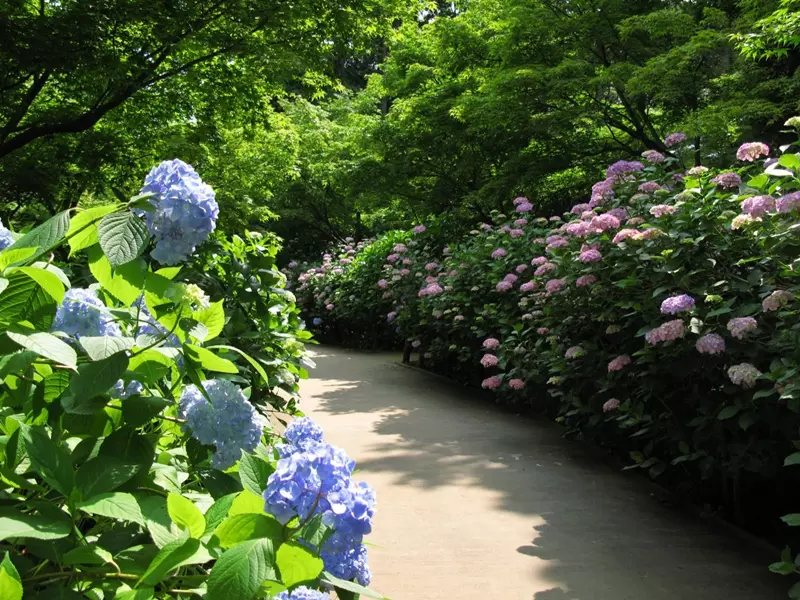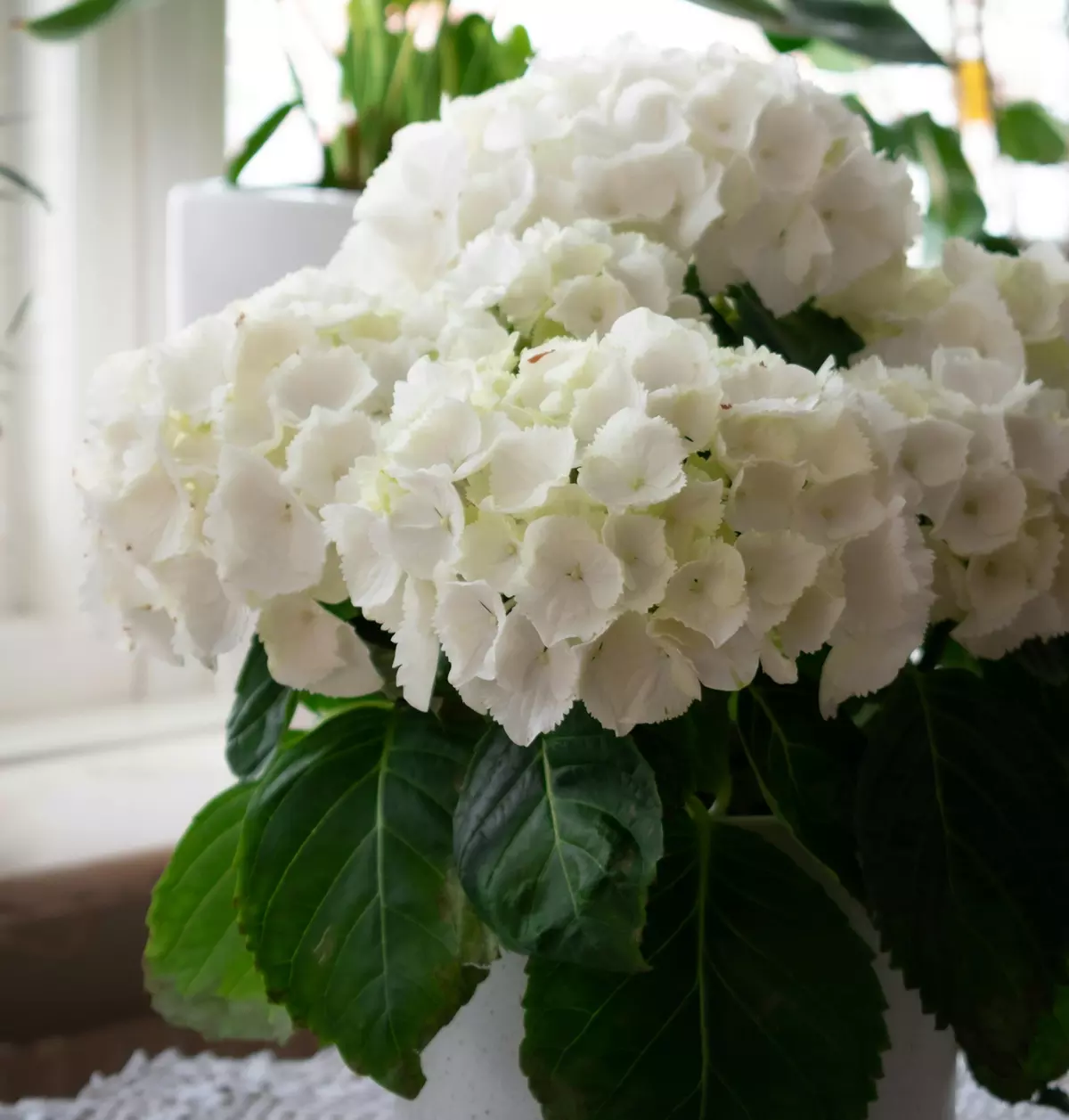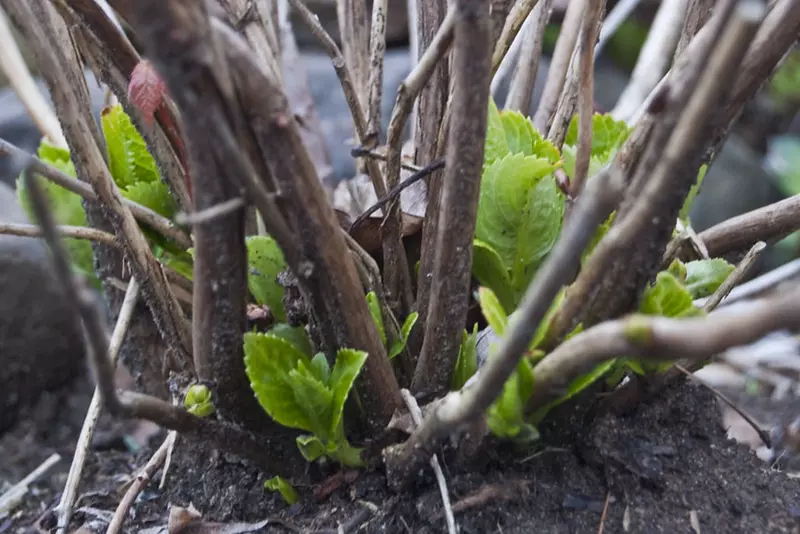
Hydrangea Varieties for Urban Gardens
Explore the best hydrangea varieties for urban gardens in the UK, including their unique features and benefits for city environments.
Read MoreHydrangea macrophylla, commonly known as bigleaf hydrangea, is cherished for its lush foliage and vibrant blooms. While traditionally grown outdoors, with proper care, these plants can also thrive indoors, bringing a touch of elegance to your interior spaces.

Successfully cultivating Hydrangea macrophylla indoors hinges significantly on providing appropriate lighting conditions. While these plants are renowned for their shade tolerance in outdoor settings, indoor environments necessitate a more nuanced approach to light exposure.
Position your indoor hydrangea in a location that receives bright, indirect light. A spot near an east or west-facing window is ideal, as it offers ample illumination without subjecting the plant to the harshness of direct sunlight. Excessive direct sun can lead to leaf scorch and dehydration, compromising the plant's health.
Morning sunlight is particularly beneficial for hydrangeas. Allowing them to bask in gentle morning rays can enhance their growth and flowering potential. However, it's crucial to shield them from intense afternoon sun, which can be detrimental.
Avoid placing hydrangeas in deep shade or poorly lit areas, as insufficient light can hinder flowering and lead to weak, leggy growth. Striking the right balance ensures that your indoor hydrangea thrives, displaying vibrant blooms and robust foliage.
Monitoring the plant's response to its lighting environment is essential. Signs such as pale leaves or reduced flowering may indicate inadequate light, prompting a need to adjust its placement. Conversely, scorched leaves suggest excessive direct sunlight, necessitating relocation to a more suitable spot.

Proper watering is crucial for maintaining the health and vibrancy of indoor hydrangeas. Understanding their specific moisture needs will ensure your plants thrive and produce abundant blooms.
Hydrangeas are known for their high water requirements, especially during blooming periods. They typically need about 1 inch (2.5 cm) of water per week, either from rainfall or irrigation. However, when grown indoors, factors such as container size, indoor climate, and potting mix can influence their watering needs.
Regularly check the moisture level of the potting mix by inserting your finger about an inch deep. If it feels dry, it's time to water. During hot or dry conditions, daily checks may be necessary to prevent the soil from drying out completely.
When watering, ensure a thorough soak so that water reaches the root zone. Allow excess water to drain out to prevent root rot. Avoid letting the plant sit in standing water, as this can lead to overwatering issues.
Hydrangeas are sensitive to chemicals commonly found in tap water, such as chlorine. Using rainwater or distilled water is preferable to maintain plant health.
Indoor environments can become drier during winter due to heating systems. Monitor soil moisture levels closely during this period, as plants may require less frequent watering.
Recognising the symptoms of improper watering is essential:
Adjust your watering practices accordingly to address these issues.
By closely monitoring and adjusting your watering habits, you can create an optimal environment for your indoor hydrangeas to flourish.
Maintaining appropriate temperature and humidity levels is crucial for the health and vitality of indoor hydrangeas. These plants thrive in specific environmental conditions that closely mimic their natural outdoor habitats.
Indoor hydrangeas flourish in cooler environments. To prolong the flowering period and ensure robust growth, it's advisable to keep them in rooms where temperatures range between 10°C and 16°C (50°F to 60°F). Higher temperatures can accelerate the drying of blooms and may lead to premature wilting.
During the blooming phase, maintaining these cooler temperatures is particularly beneficial. If the ambient temperature rises above this optimal range, you might observe the leaves turning brown and crispy at the edges, indicating thermal stress.
It's essential to protect indoor hydrangeas from sudden temperature fluctuations. Avoid placing them near heating vents, radiators, or drafty windows, as these can expose the plants to inconsistent temperatures, leading to stress and potential damage.
In regions with hot climates, ensure that indoor temperatures do not exceed 25°C (77°F). Elevated temperatures can cause the leaves and blooms to suffer, especially if the soil lacks adequate moisture.
Hydrangeas prefer environments with higher humidity levels. Indoor settings, especially during winter months, often have reduced humidity due to heating systems, which can lead to dry air detrimental to hydrangeas.
To maintain the necessary humidity:
Avoid misting the leaves directly, as this can promote fungal diseases rather than providing the desired humidity.
During winter, indoor air tends to be drier due to heating systems. It's crucial to monitor both temperature and humidity levels during this period to prevent dehydration and stress in your hydrangeas.
By diligently managing the temperature and humidity, you can create an indoor environment where your hydrangeas will thrive, rewarding you with lush foliage and vibrant blooms.
Ensuring the appropriate soil composition and fertilisation regimen is vital for the health and vitality of indoor hydrangeas. These factors significantly influence the plant's growth, bloom quality, and overall resilience.
Hydrangeas thrive in well-draining, fertile soil that retains moisture without becoming waterlogged. For indoor cultivation, it's recommended to use a high-quality potting mix enriched with organic matter. A blend containing peat moss, perlite, and pine bark can provide the necessary balance between moisture retention and aeration. Avoid using heavy garden soil, as it may compact in containers, leading to poor drainage and root health issues.
The pH level of the soil can influence the colour of hydrangea blooms, particularly in certain species. For instance, Hydrangea macrophylla can produce blue flowers in acidic soils and pink flowers in alkaline conditions. To achieve the desired bloom colour:
Regular monitoring of soil pH is essential, as fluctuations can affect bloom colour and plant health.
Proper fertilisation supports robust growth and abundant flowering in indoor hydrangeas. Consider the following guidelines:
While fertilisation is beneficial, excessive application can harm indoor hydrangeas. Over-fertilisation may lead to lush foliage with reduced flowering and can increase susceptibility to pests and diseases. Signs of over-fertilisation include leaf burn, wilting, or stunted growth. To prevent this:
For those preferring organic gardening practices, options such as compost, well-rotted manure, or organic fertilisers formulated for flowering plants can be utilised. These not only provide essential nutrients but also improve soil structure and microbial activity, contributing to the overall health of the hydrangea.
By meticulously managing soil conditions and fertilisation routines, indoor hydrangea enthusiasts can cultivate vibrant plants that enhance indoor spaces with their lush foliage and stunning blooms.
Proper pruning is essential for maintaining the health, shape, and flowering potential of indoor hydrangeas. The timing and method of pruning depend on the specific species and their blooming characteristics.
Hydrangeas can be classified based on whether they bloom on old wood (previous year's growth) or new wood (current year's growth):
When pruning indoor hydrangeas, consider the following guidelines:
Repotting is crucial for the continued health and growth of indoor hydrangeas, providing fresh soil and adequate space for root development.
The optimal time to repot hydrangeas is during late winter or early spring, while the plants are still dormant. This timing minimises stress and allows the plant to establish in its new container as growth resumes.
Indicators that your hydrangea requires repotting include:
Follow these steps to repot your indoor hydrangea:
After repotting, place the hydrangea in a location with appropriate light conditions and maintain consistent moisture levels. Avoid fertilising immediately; wait a few weeks to allow the plant to adjust to its new environment.
By adhering to proper pruning and repotting practices, indoor hydrangea enthusiasts can ensure their plants remain healthy, attractive, and capable of producing beautiful blooms year after year.
Indoor hydrangeas, while generally resilient, can occasionally fall victim to various pests and diseases. Recognising the signs early and implementing appropriate measures are crucial for maintaining healthy plants.
Several pests are known to affect indoor hydrangeas, including aphids, spider mites, scale insects, and slugs. These pests can cause significant damage if not promptly addressed.
Aphids are small, pear-shaped insects that can be green, black, or brown. They feed on plant sap, leading to yellowing and curling of leaves. Aphids also excrete honeydew, a sticky substance that can encourage the growth of sooty mould. To manage aphid infestations, regularly inspect your plants and, if detected, gently spray the leaves with water to dislodge them. For more severe infestations, consider using insecticidal soaps or neem oil.
Spider mites are tiny arachnids that thrive in hot, dry conditions. They cause deformed growth, especially on new stems, and produce fine webbing between leaves. To control spider mites, maintain adequate humidity levels and regularly mist your hydrangeas. If an infestation occurs, thoroughly hose down the plant, especially under the leaves, and consider introducing natural predators like ladybirds.
Scale insects appear as small, immobile bumps on stems and leaves. They feed on plant sap, causing weakened growth. To manage scale infestations, physically remove them using a soft brush or cloth. In cases of severe infestation, apply horticultural oils or insecticidal soaps.
Slugs are known to attack young hydrangeas, creating holes with ragged edges in the leaves. They are more active during wet conditions. To deter slugs, consider using slug traps or barriers, and maintain good garden hygiene to reduce hiding spots.
Indoor hydrangeas can be susceptible to several diseases, including powdery mildew, botrytis blight, and root rot. Understanding these diseases and their management is essential for maintaining plant health.
Powdery mildew is a fungal disease that presents as a white or grey powdery coating on leaves and stems. While it seldom kills the plant, it can cause leaves to drop prematurely. To manage powdery mildew, remove and destroy affected plant parts and ensure good air circulation around the plant. Applying neem oil can also be effective in controlling this disease.
Botrytis blight causes flower buds to die, and petals to turn brown and drop before blooming. This disease thrives in humid and cool conditions. To control botrytis blight, promptly remove and destroy infected plant parts and apply appropriate fungicides if necessary.
Root rot is often a result of poorly draining soil and leads to wilting that does not improve with watering. Affected roots may appear brown and mushy. To prevent root rot, ensure hydrangeas are planted in well-draining soil and avoid overwatering. If root rot is suspected, remove the plant from its pot, trim away affected roots, and repot in fresh, well-draining soil.
By staying vigilant and implementing proper care practices, you can minimise the impact of these pests and diseases, ensuring your indoor hydrangeas remain healthy and vibrant.
Proper seasonal care is essential for maintaining the health and vitality of indoor hydrangeas. While indoor environments offer some protection from external climatic variations, understanding and adapting to seasonal changes can significantly enhance plant growth and flowering.
As daylight increases and temperatures rise, hydrangeas enter their active growth phase. During this period:
Summer is the peak blooming season for hydrangeas. To maintain their vibrancy:
As growth slows down:
During the dormancy period:
By tailoring indoor hydrangea care to these seasonal guidelines, you can ensure robust growth and abundant blooms year after year.
While hydrangeas can be kept indoors temporarily, they thrive best outdoors where they can experience natural seasonal changes. Prolonged indoor cultivation can lead to reduced vigour and flowering.
Hydrangeas prefer consistently moist soil. Water them thoroughly when the top inch of soil feels dry, ensuring excess water drains away to prevent root rot.
Yellowing leaves can result from overwatering, nutrient deficiencies, or unsuitable soil pH levels. Ensure proper watering practices, provide balanced fertilisation, and maintain a soil pH between 5.2 and 6.2 for optimal nutrient uptake.
To promote blooming, provide bright, indirect light, avoid over-fertilisation, and ensure the plant undergoes a dormancy period with cooler temperatures during winter.
Yes, indoor hydrangeas can be transitioned outdoors. Gradually acclimate them to outdoor conditions by placing them in a shaded area initially, then slowly introducing them to more sunlight. Ensure they are planted in well-draining soil and receive adequate moisture.
Common pests include aphids, spider mites, and scale insects. Regularly inspect your plant, maintain proper humidity levels, and consider using insecticidal soaps or neem oil for infestations.
To prevent root rot, use well-draining soil, ensure pots have drainage holes, and avoid overwatering. Allow the top inch of soil to dry out between waterings.
Pruning depends on the hydrangea species. For those that bloom on old wood, prune immediately after flowering. For varieties that bloom on new wood, prune in late winter or early spring before new growth begins.
Wilting flowers can be due to underwatering, overwatering, or exposure to excessive heat. Ensure consistent moisture, avoid waterlogged soil, and protect the plant from direct afternoon sun.
Yes, the flower colour of certain hydrangea species can be altered by adjusting soil pH. Acidic soils (pH below 6) produce blue flowers, while alkaline soils (pH above 6) result in pink flowers. Use soil amendments like aluminium sulfate to lower pH or lime to raise it.
With attentive care, Hydrangea macrophylla can thrive indoors, offering year-round beauty. By understanding and meeting their specific needs-light, water, temperature, and soil-you can enjoy the lush foliage and stunning blooms that make hydrangeas a beloved choice among indoor gardeners.

Explore the best hydrangea varieties for urban gardens in the UK, including their unique features and benefits for city environments.
Read More
Learn when and how to prune your hydrangeas this spring with our detailed guide. Includes tips for tool preparation and proper pruning techniques.
Read More
A comprehensive guide on planting and caring for hydrangeas, covering site selection, soil preparation, planting steps, watering, fertilising, pruning, and pest management.
Read More